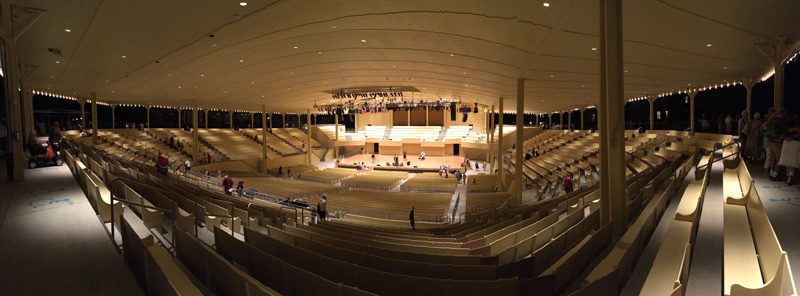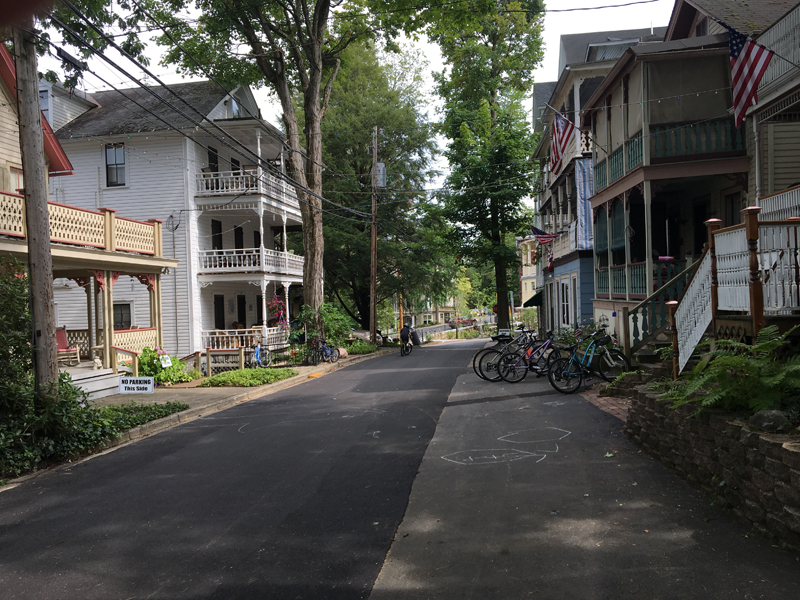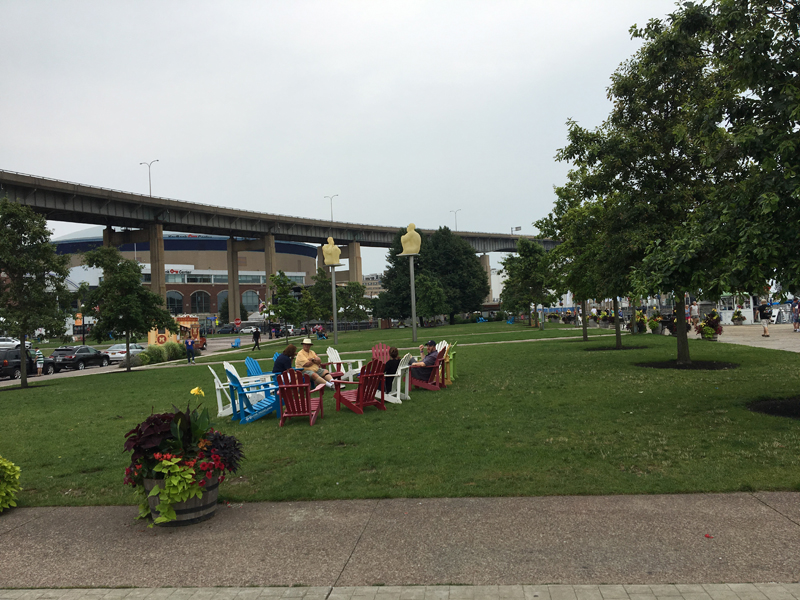
An Essay On Town Planning in Upstate New York
On a recent trip to Upstate New York, Arthur Ziegler, president of Pittsburgh History & Landmarks Foundation (PHLF), toured the historic Chautauqua community, Buffalo’s Canalside, a waterfront development on the Erie Canal Harbor in Buffalo, and Niagara Falls. He recounts the trips and some of his thoughts and observations on the history of the area, sense of place, and town planning in the essay below.
By Arthur Ziegler
It had been many years since I last visited the Chautauqua Institution near Jamestown, New York, when I drove up there a couple of weeks ago to take in a performance by Garrison Keillor, the noted author, humorist, and radio personality. The Chautauqua Institution, of course, was embroiled in considerable controversy in recent years concerning its demolition of its historic amphitheater, which had been listed on the National Register of Historic Places. We, at PHLF, joined the preservationist voices from all across the country in opposition to the Institution’s plans, but the board of directors of the Institution won out and raised over $23 million to demolish it and build what is actually a rather good replica.
From what I observed, they have created a better access for physically handicapped patrons, a large addition to the theater for back-of-the-house improvements and space needed for performers. The wooden benches and the spaces, the stage, are all replicated and the organ is in place. One would hardly know the difference but one can feel the loss of the patina of time that one felt in the former amphitheater.
For this opening week Garrison Keillor performed with two cast mates from his old radio variety show, A Prairie Home Companion, and the acoustics in the amphitheater were perfect both for performers and the several thousand attendees who joined in singing old-time songs. A new plaza will be developed in front of the theater in the coming year to make that area more inviting.
It is the planning—or lack of planning—that makes Chautauqua itself so welcoming and really endearing. There is a relative grid pattern of streets except for a curving street from the lakefront up toward the hotel. There are few curbs, few sidewalks, and yards go right to the edge of the asphalt and almost every yard has a front yard garden or little lawn. In late July, the flowers were all in bloom, making the town feel very inviting. The informality of the roads and gardens is rare in America and largely disallowed anywhere in planning today.
The architecture of Chautauqua, largely Gothic, board and batten, and some classical, is an endless treat to the eye and every time one walks for about a block, no matter how often it is repeated, one sees new details. In Chautauqua, it appears, that no house has setback requirements and there is no single-use of land i.e., a street block might have single-family houses, inns, rental cottages, lecture hall, restaurant, art center. Everything exists in harmony, a notion that runs counter to our contemporary ideas of urban planning where different uses are isolated from one another.
What they have in Chautauqua that also helps to make the community feel inviting and in-tune with nature is that shade prevails. The town is filled with great trees everywhere, a mixture of deciduous and conifers. One can walk the entire town with comfort because of its short street blocks. There, I recalled that Jane Jacobs taught us the value of short blocks.
Amidst the charm of the town, I was reminded that the community in Chautauqua was founded as a religious retreat by the Methodist churches and religion still prevails. The residents and visitors are— at least when I was there— almost entirely white, and aging. Occupants of houses now seem to be permitted to have alcoholic beverages on their porches but the great hotel has limited its offerings to wine and beer. While the artistic and intellectual programs are plentiful and varied, Chautauqua still seemed to be limited in its demographic appeal and I wondered how many of the people that were there will be there 10 years from now due to age and infirmity. In the future, I wondered: What will bring younger more diversified people there?
Buffalo
From Chautauqua, I drove farther north along I-90 to Buffalo, New York, to visit and see Canalside, a waterfront redevelopment in an historic district on the city’s inner harbor. Located within Buffalo’s Downtown, the redevelopment of the area started in 2005 when the state of New York formed the Erie Canal Harbor Development Corporation, a state agency that was charged with planning the redevelopment of this historic site to help boost Buffalo’s economic resurgence.
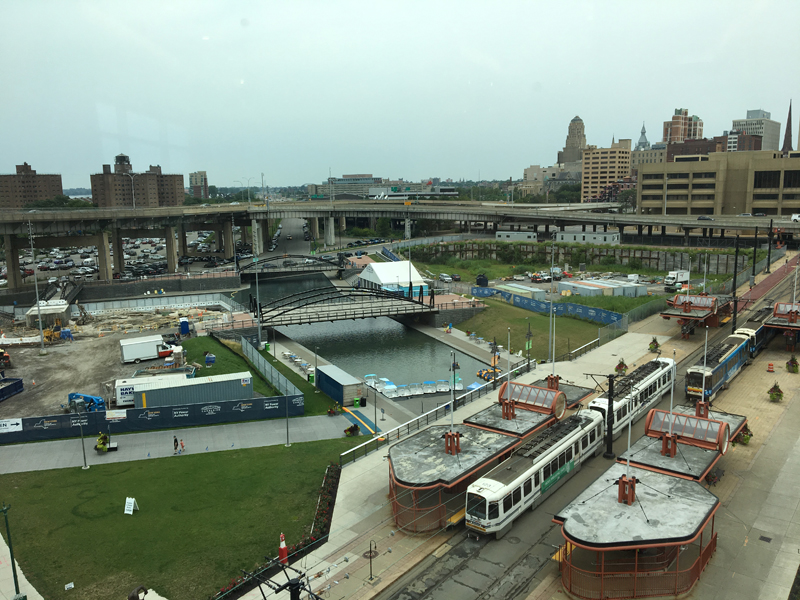 Stanton Eckstut, a leading preservation planner and architect with Perkins Eastman— and who has done considerable work with our organization over the years— was the project designer and through his vision the Erie Canal has been resurrected, water is flowing, and a Downtown playground has been established all around it with a number of developments scheduled to come.
Stanton Eckstut, a leading preservation planner and architect with Perkins Eastman— and who has done considerable work with our organization over the years— was the project designer and through his vision the Erie Canal has been resurrected, water is flowing, and a Downtown playground has been established all around it with a number of developments scheduled to come.
A light rail line comes right to the project connecting to the business area a couple of blocks away. Here is a planning triumph, I thought, in that it is bringing residents and visitors back Downtown and in the winter when the water is frozen in the canal, it is a hugely popular ice skating rink. I saw a group of youngsters enjoying hula hoops, some oldsters talking to one another in a collection of Adirondack chairs, and people enjoying views of the water, the marina, and a great naval destroyer anchored there. A highway soars over the site on concrete posts and it has been retained and people frolic underneath it.
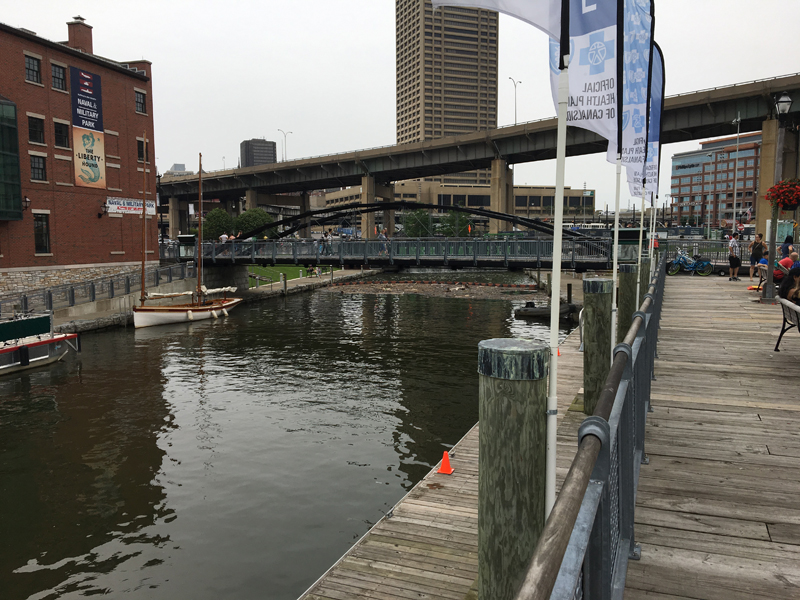 The area has been pedestrianized with easy access by vehicle and parking and various areas are treated in different ways, some with wooden boardwalks, some with lawns, some with blocks that might have been used in the ships that sailed there, old foundations from the canal and adjoining buildings have been excavated, and interpretive panels have been displayed with good graphics narrating the history of the area.
The area has been pedestrianized with easy access by vehicle and parking and various areas are treated in different ways, some with wooden boardwalks, some with lawns, some with blocks that might have been used in the ships that sailed there, old foundations from the canal and adjoining buildings have been excavated, and interpretive panels have been displayed with good graphics narrating the history of the area.
I could see that Stan Eckstut and his team sought to renew the core of the city as a major attraction by reviving its history. In doing planning anywhere, Stan first looks to the history of what happened at a particular site and then develops relevant concepts for people living, working, and playing in the space today. In Buffalo, unlike Chautauqua, people of every age and race were there in abundance and the place felt alive.
It also occurred to me that Canalside is very different from our own historic Point State Park in Pittsburgh, which is really disconnected from the rest of Downtown. Here, our history in Point State Park is treated modestly and was recently mostly covered up. It is no wonder that the park is not heavily used unless there is a special event.
At Point State Park, the museum is almost hidden away and the Block House was saved only through the intrepid determination of the Daughters of the American Revolution. The foundations of the historic buildings, historic wharfs, were all eliminated in favor of plain concrete walkways around the rivers’ edges. It is beautiful and pristine but not in any way equivalent to the educational playground I saw at Canalside.
Niagara Falls
About half an hour’s drive north of Buffalo lies the majestic Niagara Falls. On the American side of the falls, we have a Downtown whose street pattern is elusive. Traffic overwhelms the town, parking is not neatly provided. The park and the falls are hidden beyond various tourist stores in the town. Way finding is hard for pedestrian or drivers but when one finally arrives at the park, which is maintained by the National Park Service, the landscaping, unlike at Chautauqua or Canalside, leaves a lot to be desired. It feels more like the remnants of a landscaped park, with shrubs and trees looking like they need nourishment. The lawn in many places is just dirt. Granted that there are many thousands of visitors here and it can be hard to maintain landscaping but it is done across the river in Canada very well.
Signage is poor if it exists at all and one can end up driving around and around the same block or doing the same on foot because each block seems to be lined with the same tourist shops. Niagara Falls is a major world attraction and we should have there a town outstanding for its architecture and its linkages to the river and the Falls and demonstrate our country’s planning and landscaping to the best.
One very good thing that can be said about Niagara Falls is that the population is highly diversified. People from every country, every ethnic background, and every age are there and the great natural wonder of the Falls delivers a spectacle that somehow equalizes the human beings who come to enjoy it and they seem to enjoy one another.
As I reflect on my journey to this part of Upstate New York, I can’t help but wonder:
- How will Chautauqua Institute move toward the future?
- How should Buffalo work to spin off more good economic development for the future by its investment in the visionary Canalside?
- How can Niagara Falls reconfigure itself to be in itself an attraction that befits and enhances the natural attraction that brings people there?


